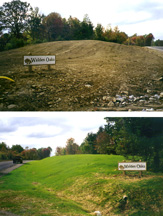 Purdue News
Purdue News
 Purdue News
Purdue News
December 19, 1997

|
Purdue researchers and their collaborators from two Soil and Water Conservation Districts in Ohio and Indiana released details of the study Oct. 15 during on-site demonstrations in northeast Ohio. The participating Soil and Water Conservation Districts are in Geauga County, Ohio, and St. Joseph County in northern Indiana.
Using a consumer survey approach, the researchers tested whether grass-covered lots are valued more highly by developers, real estate agents and home buyers than bare lots. Although developers placed little value on differences in appearance, real estate agents and home buyers placed a much higher value on grass-covered lots. In the study, home buyers perceived grassed lots to be worth $750 more than comparable bare lots.
"This increase in value is more than double the cost of seeding a residential lot, giving a 150 percent return on investment" said Martha Herzog, a Purdue graduate student in the Department of Earth and Atmospheric Science who was the lead researcher on the project. "For a 100-lot site, seeding can increase the profit on the development by $45,000."
John Law, resource specialist with the St. Joseph Soil and Water Conservation District, said covering undeveloped lots with grass also may help developers comply with local or state regulations.
"Most construction sites are required to have erosion control by state or local regulations," he said. "In this case, meeting regulatory requirements also makes good business sense."
His comments were echoed in Herzog's study, which cited findings from an environmental study by Jon Harbor, Purdue associate professor of earth and atmospheric science, that showed widespread seeding and mulching on a residential construction site reduced soil erosion by up to 86 percent.
"Soil erosion from construction sites is a significant cause of surface water quality degradation in the United States, particularly in developing areas," Harbor said. "Construction sites are a major source of pollution because as land is exposed and disturbed, soil erosion rates are dramatically increased. Much of the displaced sediment eventually reaches waterways where sedimentation can alter the physical and biological characteristics of streams, rivers, lakes and reservoirs."
Keith McClintock, district program administrator at the Geauga Soil and Water Conservation District, said: ""This is a win-win situation. In addition to increased profits, grass cover helps prevent soil erosion problems that are often associated with poorly managed construction sites."
The research group now is tracking the sale of seeded and unseeded lots in the same areas to determine the actual differences in the selling prices and in how quickly the lots sell.
The Purdue group has established a Web site at https://uval.eas.purdue.edu/~mherzog/RESpress.html that contains additional information about the project.
The project is supported by a grant from the Great Lakes Commission.
Sources: Martha Herzog, (765) 494-0258; Web, https://uval.eas.purdue.edu/~mherzog/RESpress.html
Jon Harbor, (765) 494-9610; e-mail, jharbor@purdue.edu (Dec. 23 through Jan. 5, Harbor can be reached at (765) 463-5175.)
Writer: Susan Gaidos, (765) 494-2081; e-mail, susan_gaidos@purdue.edu
Purdue News Service: (765) 494-2096; e-mail, purduenews@purdue.edu
NOTE TO JOURNALISTS: Color photos of a seeded and an unseeded lot are available. Ask
for the photos called Harbor/Lots."
Download here.
 To the Purdue News and Photos Page
To the Purdue News and Photos Page